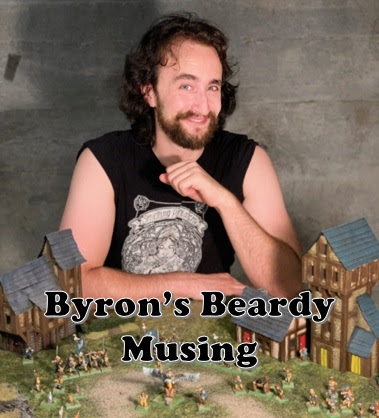Can you see over gnomes?
The following situation is not unique to gnomes. You have a unit of Knights and between them and the normal-heighted enemy is a unit of halflings, skinks, dwarves or other diminutive humanoid. The question arises, can the knights see the enemy? This question has a lot of different answers depending who you ask, and which edition of which game you play. Anyone who chooses to play with gnomes will undoubtedly encounter this question regularly, especially if they include mercenaries or allies in their armies.
In the above example it is super clear that in a "realistic" world the empire troops on the left would be able to see the orcs on the right. In games with a so-called "true LOS" rule this question is easily settled.
However, as a hobbyist I am more interested in systems that don't use "true LOS" namely warhammer fantasy 3rd ed through the 6th ed. Each of these rule books contains the same passage
"Imagine a real battlefield with its contours, morning mists and haze of dust. Picture the woods and hedges that obscure vision, the sudden fall of ground that hides your enemy and the distances that blur friend with foe. Towering above the miniature battlefield we are aware of all that happens, but the troops represented by our models would not be so fortunate. Just as their real like counterparts cannot see through hills or behind hedges, so we must assume our models cannot see behind corresponding scenic features...."
This passage asks us to consider what we might call a "battlefield LOS." That is, in considering what can and cannot be seen we are to, in instances of doubt, imagine dust, fog, and undulating terrain that might prevent a target from being seen.
All four editions then have a series of "guidelines" about what does and does not block LOS. Each of these editions then has a guideline addressing interposing units or "troops, friendly or unfriendly." Across all four editions these guidelines concur that troops block LOS.
On their face these rules seem clear and categorical. There are, however, other instances that serve to muddle this clear categorical human-centric [it all seems consistent if all the models are the same human size] logic. However, hills and large targets are an exception to these rules. A tall giant may be seen beyond interposing infantry models. And, a unit atop a hill may see over an interposing unit. What these exceptions dangle in front of us is the tantalizing principle that there is an undetermined height at which one gains the ability to see over an interposing unit. And, inversely, that if your unit is short enough it can be seen over. The temptation is then to say "my gnomes fit in this category."
In deciding this contrived dilemma, the following logic is persuasive to me. The advantage that would be gained by the interpretation is not accounted for in their point value. (not to mention that it might open the door to other exceptions.) That is, while the point values in warhammer are not perfect, and many people, especially in the Oldhammer community, object to the very idea of points having any bearing, the points do attempt to code fairness into the game. Model height is not factored into the calculus, even incidentally. Allowing one to see over gnomes, would allow a player to double the density of their ranged fire power. A player could hypothetically field both human and gnome crossbowmen in two "ranks." [perhaps a third of mounted crossbowmen] In a narrow battlefield with scant room for additional troops, this advantage in firepower could be decisive. Allowing players to account for the physical height of their gnome models would be just like players who "model for advantage" in "true LOS" rule systems. It would be granting them an advantage strictly outside of the rules. Few people like to lose to beardy chicanery because their opponent's physical models change key game mechanics. In every game we want to encourage player creativity, but we also want to encourage fair play.


No comments:
Post a Comment